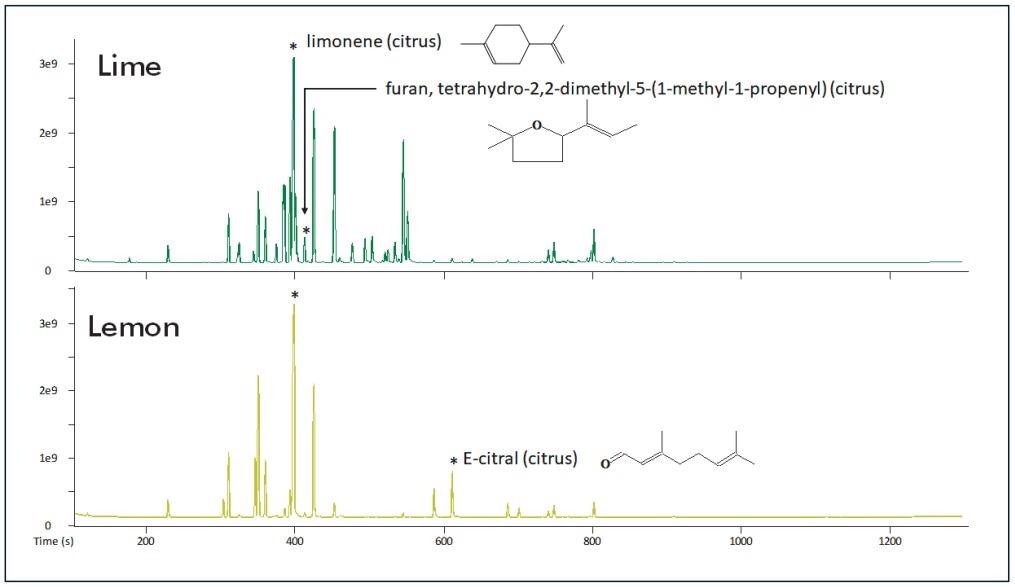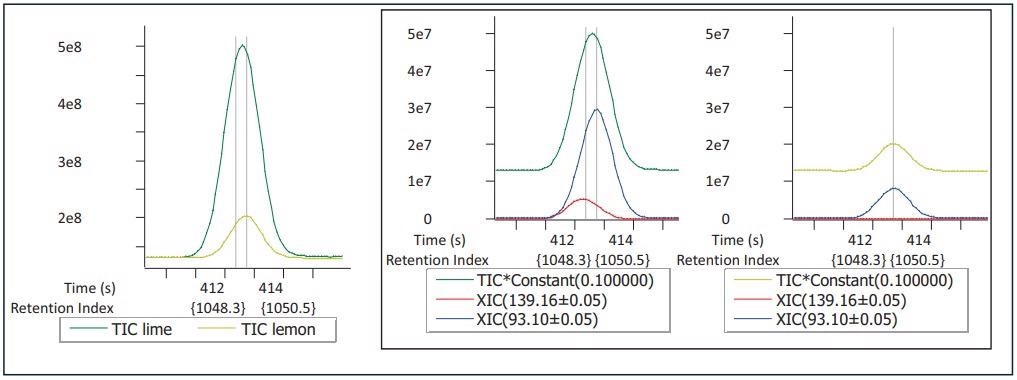Lemons and limes each have potent citrus odors, but there is a significant difference between these fruits from an analytical perspective.

Image Credit: Shutterstock / Lens7
Identifying these differences is not always a straightforward task, but the Pegasus® BT and the ChromaTOF® automated data processing software from LECO make finding and discerning the different peaks of the samples simple.

TIC Chromatogram for lemon and lime essential oils. Key analytes with citrus odor types are highlighted. Image Credit: LECO Corporation
The image below shows an example GC-MS chromatogram for lemon and lime essential oils, highlighting key analytes with citrus odor types.
An examination of this chromatogram reveals clear similarities and differences. For example, both citrus oils are high in limonene - a compound that exhibits strong citrus odor characteristics.
In contrast, E-citral has been resolved at a much higher level in lemon essential oil than in its lime counterpart. This is also a citrus-odor compound, but it is much more clearly defined in one sample.
Comparing chromatograms using the naked eye does not tell the full story, however. In the example presented here, a peak is present in the lime essential oil that is much lower in the lemon essential oil, suggesting that there is much more of one compound in the lime sample.
The ChromaTOF® brand software’s automated peak finding capabilities enabled the analysts to confirm that this peak was caused by the coelution of two distinct analytes.
Tetrahydro-2,2-dimethyl-5-(1-methyl-1-propenyl)-furan was only present in the lime essential oil sample. Its citrus odor properties included spicy, minty, and woody notes. This analyte’s presence had been entirely obscured by the presence of trans-ß-ocimene, which exhibits herbal odor properties.

What appeared to be one analyte at higher levels in lime compared to lemon, was deconvoluted to two distinct analytes. One is higher in lime than lemon (m/z 93.10) and the other was only observed in lime (m/z 139.16). Image Credit: LECO Corporation
In the example presented here, the analysts had observed one analyte at higher levels in lime versus lemon, but this was actually two distinct analytes – a detail that became evident after deconvolution using the ChromaTOF® brand software.
One analyte is higher in lime than lemon (m/z 93.10), while the other analyte was only observed in lime (m/z 139.16).
These important and easy-to-miss differences were highlighted by leveraging powerful deconvoluting software and the sensitive, full-mass-spectra scan of the Pegasus BT.
About LECO Corporation.jpg)
In 1936, the Laboratory Equipment Company introduced the first rapid carbon determinator to the American iron and steel industry. Today, 75 years later, LECO is recognized globally as a leader in innovative analytical instrumentation, mass spectrometers, metallography and optical equipment, and consumables.
LECO's broad selection of innovative instrumentation incorporates trendsetting automation, easy-to-use software, and the latest technologies into ergonomic designs. This results in instruments that are fast, accurate, and user-friendly—allowing you to increase productivity by achieving a level of throughput that was once unobtainable for many lab managers.
Our four diverse product lines offer you analytical solutions in five different market areas, meeting objectives for a wide variety of applications and scientific techniques. These market areas are described below.
Inorganic analysis
Determinators for carbon, sulfur, hydrogen, nitrogen, and oxygen used for metal and inorganic analyses; glow discharge spectrometers for bulk and/or quantitative depth profile analysis.
Organic analysis
Determinators for carbon, sulfur, hydrogen, nitrogen, and oxygen; analyzers for fat, protein, ash/moisture, mercury, and calorific value.
Microstructural analysis
Metallographic sample preparation equipment; macro and microindentation hardness testers; microscopes; image analysis and management systems; optical accessories.
Separation science (Mass spectrometry)
Fast GC-TOFMS and LC-TOFMS systems with ChromaTOF® software dedicated to a wide variety of organic applications; GCxGC-TOFMS and GCxGC FID/ECD systems offer increased separation power.
Ceramics
Crucibles, ladles, stopper rods, nozzles, kiln furniture, and pressed refractory shapes for the foundry and investment casting industry.
Sponsored Content Policy: News-Medical.net publishes articles and related content that may be derived from sources where we have existing commercial relationships, provided such content adds value to the core editorial ethos of News-Medical.Net which is to educate and inform site visitors interested in medical research, science, medical devices and treatments.